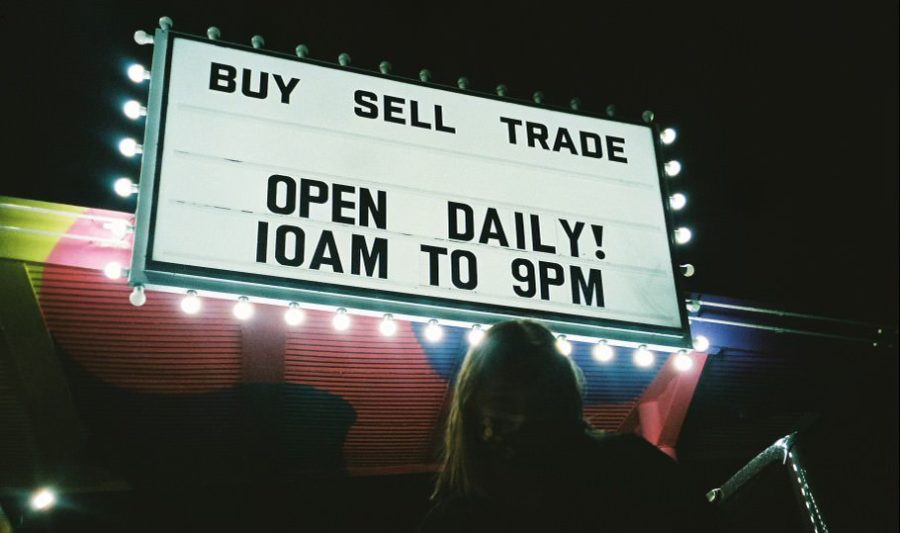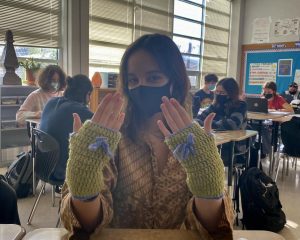Fighting fast fashion means slowing down
Knights reduce clothing consumption with thrifting, education, advocate for small change making big impact
Junior Lucy Kuhn poses in front of Pavement, an Austin thrift store that buys used items from the public. Kuhn works to stay sustainable by shopping entirely second hand.
April 6, 2023
It’s March of 2020. The COVID-19 pandemic has just begun.
Stuck at home with nothing to do, then-eighth grader Lucy Kuhn placed an online clothing order at Nordstrom.
But in the following weeks with little to do and boredom seeping into everyday life, Kuhn began to pour her energy into something new. Something important. Something to fight: Fast fashion.
That Nordstrom purchase was the last fast-fashion purchase Kuhn has made in over two and a half years. She’s made it a priority not to.
“When I go out every day, I don’t want to be thinking about where my outfit came from,” said Kuhn, now a junior. “Because people die in these factories constantly, and I don’t want to be thinking if someone was injured or if someone was paid fairly for what I’m putting on my body every day.”
Fast fashion is the method used by many popular brands to cheaply and quickly make clothing to keep up with trending styles. Due to the ever-changing nature of fashion trends, however, this often leads to the overproduction of poorly made garments.
Because it’s cheaper to outsource labor, most fast fashion companies produce clothing in garment factories where working conditions are poor and laborers are exploited.
“I think the more impactful element was the labor conditions for those working in fast-fashion factories, especially because they are typically women and women of color who are working in those conditions,” Kuhn said. “Harassment is really common in factories, and complaints on conditions are constantly ignored.”
Many culprits of fast fashion include companies like Zara, H&M and Forever 21; however, there are many more that go unnoticed.
“It’s brands people don’t even realize,” Kuhn said. “I think people often think that it’s just Shein, but even very expensive designer brands use unethical labor with just so many human rights atrocities that I think most people just ignore.”
Recently, the Levi’s company has been under scrutiny for not signing on to an international accord for workers health and safety in Bangladesh and Pakistan.
Source: Oxfam, a confederation of 21 independent charitable organizations focusing on the alleviation of global poverty. Infographic by Francie Wilhelm.
“I think that companies are very good at using marketing to save face,” Kuhn said. ‘Levi’s, for example, is very good at putting on this face of being an American brand that’s made America when in reality, they often aren’t. And they use marketing commercials and very good PR and legal teams that take care of a lot of their outward appearance to consumers.”
Correcting the misleading information spread by the fashion industry is something that world geography teachers at McCallum are working to do. The world geography curriculum has long included a lesson wherein students watch Andrew Morgan’s The True Cost, a 2015 documentary that exposes some of the ethical and environmental problems created by fast fashion.
Social studies teacher Greg Anderson feels that the documentary is an effective tool in exposing students to the potentially unfamiliar concept of fast fashion.
“I think it’s very well done and it’s appealing,” Anderson said. “It gets their attention. We show documentaries every once in a while in social studies, and you’ll see a lot of people maybe not paying attention or working on something else. This one they seem to have a actual response to, and then they want to talk about it. They come back over the next few days and they did some independent research. They look up these things on their own, and they find out how impactful this is. And how it’s not just some scare tactic used by a documentary or anything like that. It’s all backed up by facts and evidence.”
While the documentary places emphasis on labor practices employed by clothing brands, the fast fashion crisis isn’t just industry-based. Kuhn believes that a driving factor in the prominence of fast fashion is a general culture of overconsumption.
“We just don’t have the kind of resources that we need to be able to find solutions to how fast our consumption is increasing,” Kuhn said. “When people donate the clothes that they bought, I don’t think they realize that a majority of those clothes aren’t going to get bought, so that’s not just a solution. We can sit there and act like just because we go donate somewhere it’s gone, but in reality, it’s not gonna be gone for hundreds of years.”
Kuhn learned more about the costs of the fast fashion industry when she watched the 2015 documentary The True Costin her freshman world geography class. She know says the documentary does a good job of exposing the role of the fast fashion industry but that the phenomenon is a broader societal problem caused by overconsumption. Trailer accessed on the Untold YouTube Channel.
Anderson believes the world geography lesson helps students understand the consequences of overconsumption.
“[Students] think that maybe because they’re buying an outfit for a good price that they can get more of something, and there’s no side effects or consequences from that,” Anderson said. “It’s easy to see the damages from power plants from industrial output. But a lot of people don’t see that connection with something like a cheap shirt and labor practices that might not treat someone well or pay them a good wage. I don’t think they see how this mass production and then encouragement to consume on unnecessary levels can spiral out into a global environmental issue as well.”
Kuhn advises cultivating a personal wardrobe, researching fast fashion brands and shifting to shopping at second-hand stores as beginning steps for those looking to cut out fast fashion.
“It can be difficult for a lot of people to get started,” Kuhn said. “But I think that really just looking at what you own and finding out what you really do need and what they don’t need is a really good way to go about it. It starts with more analysis rather than going out and thrifting all these things now. That’s just consuming more.”
Although fighting fast fashion and its repercussions is often like fighting an uphill battle, Kuhn tries to stay optimistic, for herself and to set an example for those around her.
“There is definitely something to be said about the pressure being put on individuals to solve the climate crisis,” Kuhn said. “But in reality, it is major companies that do need to be held [accountable] because they are still the ones who are profiting off of labor and degradation of environment. But I think that if we are all going in with mindset that we can’t make a difference, then we’re all going to continue to have unhealthy consumption habits. But if we all start to make smaller changes, it can lead to a bigger impact.”








maddie oconnor • Apr 12, 2023 at 2:51 pm
i think this is a really good story because it spreads the message of how important it is to stop- buying fast fashion
estefani t.a. • Apr 10, 2023 at 2:50 pm
I’m glad McCallum has brought more attention to this topic because it’s us most teenagers that buy so many clothes that are “trendy” and we’ll just use them once or twice and that’s about it. Also, it’s true that it’s not only the cheap brands that are a part of this problem but also the big luxurious brands that are part of this problem.